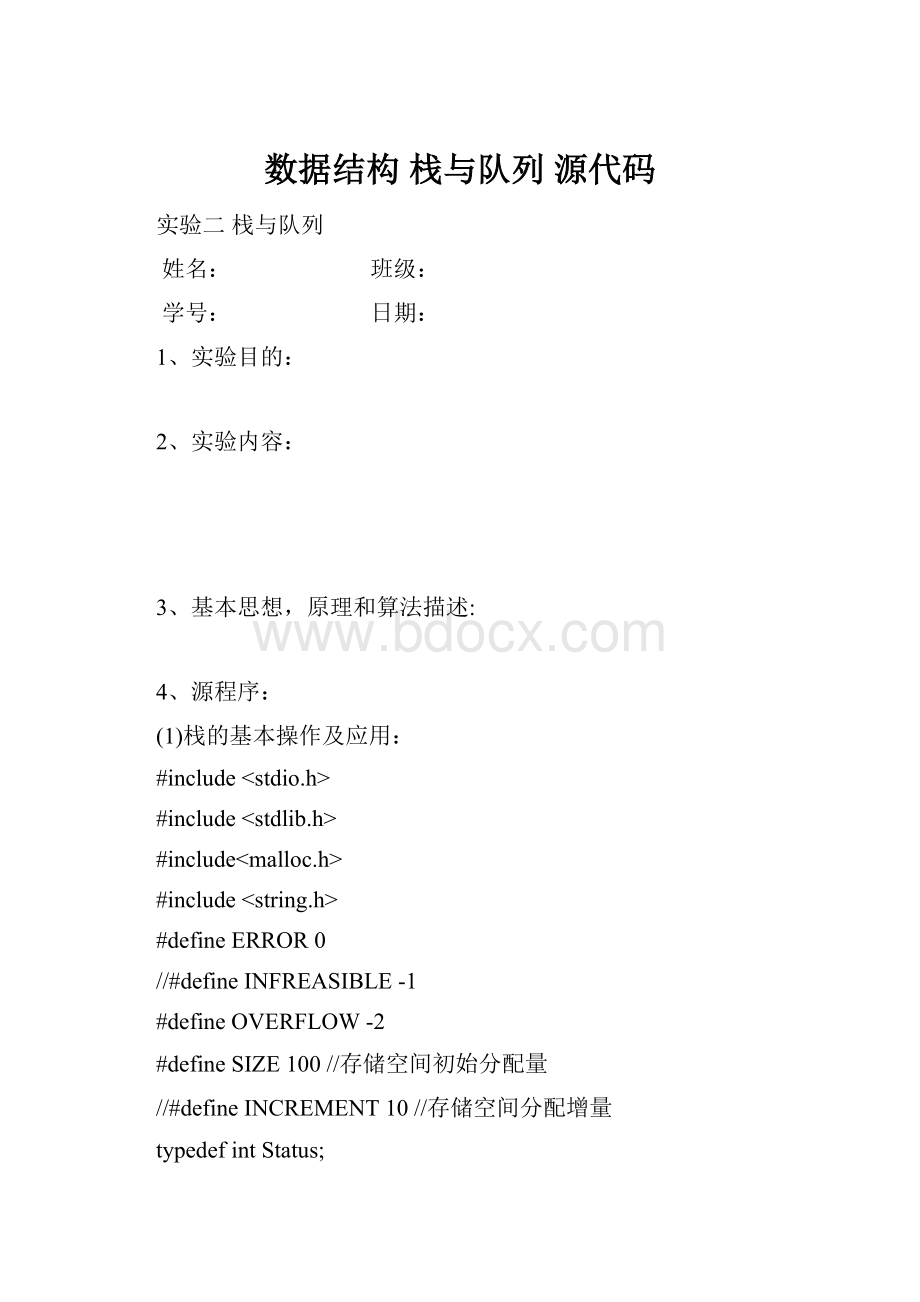数据结构栈与队列 源代码.docx
《数据结构栈与队列 源代码.docx》由会员分享,可在线阅读,更多相关《数据结构栈与队列 源代码.docx(25页珍藏版)》请在冰豆网上搜索。

数据结构栈与队列源代码
实验二栈与队列
姓名:
班级:
学号:
日期:
1、实验目的:
2、实验内容:
3、基本思想,原理和算法描述:
4、源程序:
(1)栈的基本操作及应用:
#include
#include
#include
#include
#defineERROR0
//#defineINFREASIBLE-1
#defineOVERFLOW-2
#defineSIZE100//存储空间初始分配量
//#defineINCREMENT10//存储空间分配增量
typedefintStatus;
#defineTRUE1
#defineFLASE0
#defineOK1
typedefstruct
{
int*top;//栈顶指针
int*base;//栈底指针
intstacksize;//当前已分配的存储空间
}SqStack;
StatusInitStack(SqStack*s)//初始化
{
s->base=(int*)malloc(SIZE*sizeof(int));
if(!
s->base)
exit(OVERFLOW);
s->top=s->base;
s->stacksize=SIZE;
returnOK;
}
StatusClearStack(SqStack*s)//置空
{
s->top=s->base;
returnOK;
}
StatusDestroyStack(SqStack*s)//销毁
{
ClearStack(s);
free(s->base);
returnOK;
}
StatusStackEmpty(SqStack*s)//判断是否为空
{
if(s->top==s->base)
{
returnTRUE;
}
else
{
returnFLASE;
}
}
StatusGetTop(SqStack*s,int*e)//取栈顶
{
//若栈不空,则用e返回S的栈顶元素,并返回OK;否则返回ERROR
if(s->top==s->base)
{
returnERROR;
}
*e=*(s->top-1);
returnOK;
}
StatusPush(SqStack*s,inte)//进栈
{
//插入元素e为新的栈顶元素
if(s->top-s->base>=s->stacksize)
{
//栈满,追加存储空间
s->base=(int*)malloc(SIZE*sizeof(int));
if(!
s->base)
exit(OVERFLOW);
s->top=s->base+s->stacksize;
s->stacksize+=SIZE;
}
*(s->top)++=e;
returnOK;
}
StatusPop(SqStack*s,int*e)//出栈
{
//若栈不空,则删除S的栈顶元素,用e返回其值,并返回OK;否则返回ERROR
if(s->base==s->top)
returnERROR;
*e=*--s->top;
returnOK;
}
StatusStackTraverse(SqStack*s)//遍历
{
while(s->top!
=s->base)
{
printf("%d\t",*--s->top);
}
returnOK;
}
StatusConversion(SqStack*s,intN)//进制转换
{
intm;
printf("输入R进制");
scanf("%d",&m);
inte;
while(N){
Push(s,N%m);
N=N/m;
}
while(s->top!
=s->base)
{
Pop(s,&e);
printf("%d",e);
}
returnOK;
}
intmain()
{
SqStacksq;
InitStack(&sq);
inte;
intN;
intk;
intn=0;
Z:
{
printf("\n\t********************************************");
printf("\n\t***请你输入相应的操作序号进行操作***");
printf("\n\t***1.初始化***");
printf("\n\t***2.置空***");
printf("\n\t***3.销毁***");
printf("\n\t***4.是否空***");
printf("\n\t***5.取栈顶元素***");
printf("\n\t***6.进栈***");
printf("\n\t***7.出栈***");
printf("\n\t***8.遍历***");
printf("\n\t***9.进制转换***");
printf("\n\t***0.退出***\n");
printf("\t********************************************");
printf("\n请选择功能:
");
scanf("%d",&k);
switch(k){
case1:
InitStack(&sq);
gotoZ;
break;
case2:
ClearStack(&sq);
gotoZ;
break;
case3:
DestroyStack(&sq);
gotoZ;
break;
case4:
if(StackEmpty(&sq)){
printf("该栈为空!
");
}
else
{
printf("该栈非空!
");
}
gotoZ;
break;
case5:
GetTop(&sq,&e);
printf("栈顶元素为:
%d",e);
gotoZ;
break;
case6:
printf("请输入要进栈的元素:
");
scanf("%d",&e);
Push(&sq,e);
gotoZ;
break;
case7:
Pop(&sq,&e);
printf("%d",e);
gotoZ;
break;
case8:
StackTraverse(&sq);
gotoZ;
break;
case9:
printf("请输入要转换的十进制数字:
");
scanf("%d",&N);
printf("转换后R进制的数字为:
");
Conversion(&sq,N);
gotoZ;
break;
case0:
exit(0);
break;
default:
break;
}
}
}
(2)队列的基本操作:
#include
#include
usingnamespacestd;
#defineTRUE1
#defineFLASE0
#defineOK1
typedefstructQNode{
chardata;
structQNode*next;
}QNode,*Queue;
typedefstruct{
Queuefront;
Queuerear;
}LinkQueue;
voidInitQueue(LinkQueue&Q)//创造空队
{
Q.front=Q.rear=(Queue)malloc(sizeof(QNode));
if(!
Q.front)
{
cout<<"OVERFLOW"<}
Q.front->next=NULL;
//returnOK;
}
voidEnQueue(LinkQueue&Q,inte)//入队
{
Queuep=(Queue)malloc(sizeof(QNode));
p->data=e;
p->next=NULL;
Q.rear->next=p;
Q.rear=p;
//returnOK;
}
voidDeQueue(LinkQueue&Q,inte)//出队
{
Queuep=(Queue)malloc(sizeof(QNode));
if(Q.front==Q.rear)
{
cout<<"队空"<}
p=Q.front->next;
e=p->data;
Q.front->next=p->next;
if(Q.rear==p)
Q.rear=Q.front;
free(p);
cout<}
intlength(LinkQueue&Q)//求队列中元素个数
{
Queuep=(Queue)malloc(sizeof(QNode));
p=Q.front->next;
inti=0;
while(p!
=NULL)
{
p=p->next;
i++;
}
cout<<"队列中元素个数:
"<cout<return1;
}
intQueueEmpty(LinkQueue&Q)//判队列空
{
if(Q.front==Q.rear)
returnTRUE;
else
returnFLASE;
}
intmain()
{
LinkQueueQ;
intk;
Z:
{
cout<<"\n\t********************************************"<cout<<"\n\t***请你输入相应的操作序号进行操作***"<cout<<"\n\t***1.初始化***"<cout<<"\n\t***2.入队***"<cout<<"\n\t***3.出队***"<cout<<"\n\t***4.求队列中元素个数***"<cout<<"\n\t***5.判队列是否为空***"<cout<<"\n\t********************************************"<cout<<"\n请选择功能:
"<cin>>k;
switch(k)
{
case1:
InitQueue(Q);
gotoZ;
break;
case2:
cout<<"请输入要插入的元素"<inte;
cin>>e;
EnQueue(Q,e);
gotoZ;
break;
case3:
cout<<"出队"<intm;
DeQueue(Q,m);
gotoZ;
break;
case4:
length(Q);
gotoZ;
break;
case5:
if(QueueEmpty(Q))
cout<<"队列为空"<else
cout<<"队列不为空"<gotoZ;
break;
default:
break;
}
}
}
(3)判断回文:
#include
#include
#include
constintSTACK_INIT_SIZE=100;//初始分配的长度
constintSTACKINCREMENT=10;//分配内存的增量
//链式队列结构的定义
typedefcharElemType;
typedefstructNode
{
chardata;//元素数据
structNode*next;//链式队列中结点元素的指针
}QNode,*QueuePtr;
typedefstruct
{
QueuePtrfront;//队列头指针
QueuePtrrear;//队列尾指针
}LinkQueue;
//栈结构的定义
typedefstructStack
{
ElemType*base;
ElemType*top;
intstacksize;
}SqStack;
boolInitQueue(LinkQueue*Q)
{
Q->front=Q->rear=(QueuePtr)malloc(sizeof(QNode));
if(!
Q->front)
{
exit(0);
}
Q->front->next=NULL;
returntrue;
}
boolEnQueue(LinkQueue*Q,ElemTypee)
{
QueuePtrp=(QueuePtr)malloc(sizeof(QNode));
if(!
p)
{
exit(0);
}
p->data=e;
p->next=NULL;
Q->rear->next=p;
Q->rear=p;
returntrue;
}
boolDeQueue(LinkQueue*Q,ElemType*e)
{
if(Q->front==Q->rear)
{
returnfalse;
}
QueuePtrp=Q->front->next;
*e=p->data;
Q->front->next=p->next;
if(Q->rear==p)
{
Q->rear=Q->front;
}
free(p);
returntrue;
}
boolInitStack(SqStack*S)
{
S->base=(ElemType*)malloc(STACK_INIT_SIZE*sizeof(ElemType));
if(S->base==NULL)
{
returnfalse;
}
S->top=S->base;
S->stacksize=STACK_INIT_SIZE;
returntrue;
}
boolPush(SqStack*S,ElemTypee)
{
if(S->top-S->base>=S->stacksize)
{
S->base=(ElemType*)realloc(S->base,(S->stacksize+STACKINCREMENT)*sizeof(ElemType));
if(!
S->base)
{
returnfalse;
}
S->top=S->base+S->stacksize;
S->stacksize+=STACKINCREMENT;
}
*(S->top++)=e;
returntrue;
}
boolPop(SqStack*S,ElemType*e)
{
if(S->top==S->base)
returnfalse;
*e=(*--S->top);
returntrue;
}
intmain()
{
//声明一个栈一个队列
SqStackS;
LinkQueueL;
//初始化一个栈一个队列
InitStack(&S);
InitQueue(&L);
charc[30];
ElemTypea,b;
printf("请输入要判断的字符,以@结束:
");
scanf("%s",c);
inti=0;
intflag1=0;
intflag2=0;
while(c[i]!
='@')
{
Push(&S,c[i]);//入栈
EnQueue(&L,c[i]);//入队列
flag1++;
i++;
}
while(!
(S.top==S.base))
{
Pop(&S,&b);//出栈
DeQueue(&L,&a);//出队列
if(a==b)
{
flag2++;
}
else
{
break;
}
}
if(flag1==flag2)
{
printf("Right\n\n");
}
else
{
printf("Wrong\n\n");
}
system("pause");
return0;
}
5、运行结果分析:
栈的基本操作及应用
图1:
栈
图2:
进栈
图3:
出栈
图4:
读取栈顶元素
图5:
判断是否为空
图6:
数值的进制转换
队列的基本操作
图7:
队列
图8:
入队
图9:
求队列中的元素个数
图10:
出队列
图11:
判断是否为空
判断回文
图12:
判断回文
6、实验总结: